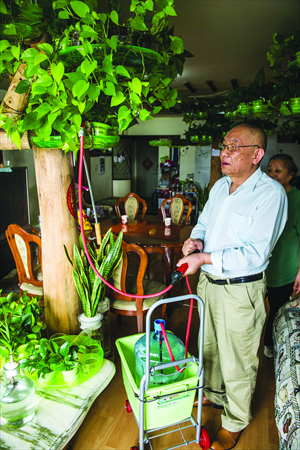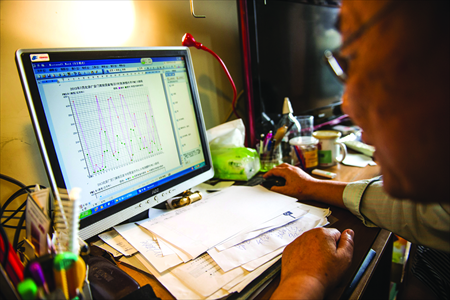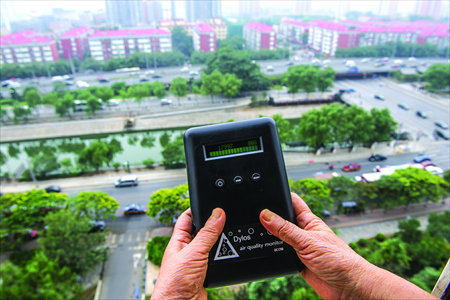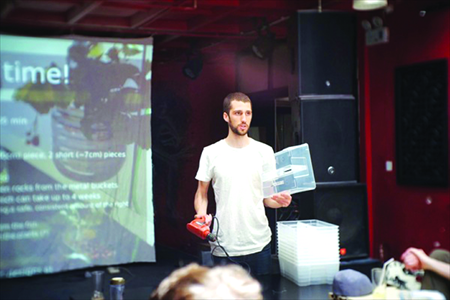It’s a jungle in there

Inventor Lü Kejian shows off his tree-shaped home irrigation system. Photo: Li Hao/GT
Lü Kejian has spent two decades building a forest inside his apartment, nestled among Beijing's skyscrapers. He believes mankind is descended from apes and shares with them a deep attachment to trees. Lush vegetation dominates his living room. The room, located on the 12th floor of a building near the Southwest Second Ring Road that has a sweeping view of the mountains to the west, is filled with six "man-made" trees. The trunks are hand built using paulownia wood. Flowerpots overflowing with money plant leaves sit atop the "branches" radiating out of the trunks.
While urbanites in Beijing have long planted indoor gardens for their beauty and calming effects, in recent years increasingly severe concerns over air pollution and food safety have led many to grow plants to protect their health.
"There has been a worldwide consensus that a large number of interior plants can make life healthier," said Lü, 75, an energetic retired aerospace engineer, and one of the country's urban garden lovers. "The difficulties, however, lay in the question of how exactly to green your living room."
Urban jungle
Sitting comfortably on his sofa under the lush canopies of fake trees, the indoor planting expert is talkative while expounding on his project. The sound of birds tweets from a stereo. The atmosphere inside is beautiful and colorful, in contrast to the dismal gray day outside.
Lü started building the trees after he moved into the apartment in 2009. "Now there are 4,800 plants in total in the 48-square-meter space," he said, noting that this works out to 10 plants for each square meter. He believes the sheer mass of plants can relax and nurture the human body by providing pleasant views and higher humidity, not to mention their ability to scrub tiny pollution particles from the air.
Pointing to the blueprints of his homemade mechanical trees, he explains that he borrowed from nature's arboreal growth principles. The wooden trunk is screwed together from modular wood components. The upper branches are created with steel braces.
Then there are the unique "leaves." Lü invented the plastic, circle-shaped water containers, which are installed on the stems to hold the flowerpots that are fed by hydroponics. Sponges are used inside flowerpots to keep the roots moist, reducing the weight of the water. Money plants were chosen because they grow easily in any water vessels. The tiers upon tiers of plants simulate the feel of tree canopies.
"It is very simple to irrigate the plants," Lü said as he pushed out a small wheeled vehicle that contains a plastic barrel for purified water. He used a small water pump to feed water into the containers through a rubber conduit.
"This is the most approachable solution for growing 'trees' inside," Lü added with confidence. Over the past two decades, he and his wife Wang Lizhi, 74, a retried missile engineer, have tried various ways to make growing indoor plants accessible. Their attempts include using mini greenhouses equipped with water sprayers, as well as covering an entire wall with plants. Their inventions wowed many DIY garden lovers and even attracted professional botanists. His experiments finally evolved into the modular tree project, which has won a patent under his son Lü Yigong's name.
Pollution protection
Lü said that his DIY trees belong in ordinary people's homes, because they can work as an air humidifier and air purifier. "The device can be popularized because all the apparatus can be manufactured according to my engineering drawings," he explained.
The couple has started regularly recording the PM 2.5 air pollution figures in the outdoor environment near his home, in his apartment and in his neighbor's apartment, which has no trees. They want to prove that the plants can help reduce PM2.5 levels and the associated health risks.
"People spend most their time in their homes, and that is why tackling the indoor PM 2.5 problem is so important," he said.
According to their data, the PM 2.5 figures in his living room are much lower than in his neighbor's room or outside. For example, on August 27 when Metropolitan visited, the outdoor PM 2.5 figure was 105 ug/L, while his home was 27 ug/L at 8 pm.
He is satisfied with the result, because "the data is lower than the level required by World Health Organization, which is the 35 ug/L."
In April 2012, environment protection volunteers from Green Beagle, a Beijing-based NGO, came to his home, and made a comparison of the PM 2.5 data in and outside. Their monitor also suggests that Lü's home has fewer particles in the air.
Feng Yongfeng, an environmentalist and founder of the Green Beagle, said residents' personal hobbies nurturing plants should be encouraged. In his opinion, however, the more fundamental measures for tackling the city's PM 2.5 problem depend on the government's efforts to reduce pollution.

Lü Kejian. Photo: Li Hao/GT

Checking air pollution readings. Photo: Li Hao/GT
Fish food
The persistence of food scandals has also driven many to use the limited space in their living rooms and balconies for planting vegetables. The passion for urban farming is also fueled by the quest for organic food. Aquaponics, a farming technology that has been widely applied in Australia, has spread to China.
Like Lü Kejian, Shanghai-based David Li, founder of Xichejian, a hackerspace (public lab for inventors), has also tested every possibility for growing plants at home.
"At first I attempted to grow vegetables in soil. But the soil overflowed, and dropped into the pipeline, resulting in blockages," he recounted. Then he turned to hydroponics, growing plants in water without soil, but the nutrient solution also caused plants to grow in the water pipes. Finally, he learned about aquaponics from the Internet, and invited foreign experts to China to introduce the technology that combines hyrdoponics and aquaculture.
In Beijing, American Tim Quijano has established a small community with his peers to exchange their experience in aquaponics. In July, Quijano ran two small workshops , in which participants built their own aquaponic herb gardens. The workshops attracted dozens of people, with some hoping to share their experiences, and others coming to learn.
The equipment required for the system is simple: A fish tank, fish, a water pump, a light source, and a plastic box to create an upper layer over the water for the plants. The ecosystem works because the fish eat and create waste. The waste and water will be pumped into the upper layer to fertilize and water the plants. The plants in return provide food for the microorganisms in the water that can feed the fish. In the system, plants and fish are edible.
According to data from Aquaponics UK, a non-profit organisation providing support for the growing aquaponics industry, a kilogram of fish food can produce at least 50 kilograms of vegetables and 0.8 kilograms of fish, a great return on investment and effort.

Tim Quijano. Photo: Courtesy of Alvin Lin
Home grown
For simple DIY projects, popular vegetables include tomatoes, cucumbers, mint, basil and cherry tomatoes, while many breeds of fish are suitable, including tilapia and tiny goldfish, said Li.
Li believes DIY aquaponics is worth promoting among city dwellers because "it solves two problems which often face gardening lovers: pouring too much water on the plants or forgetting to water them."
But there are still interesting failures he has experienced. Once he planted too much mint. He threw three mojito parties within a month. In another mishap, the system was thrown out of whack when the smaller fish were eaten by the bigger tilapia.
Quijano, a special projects director with the Beijing Energy Network, and a Beijing Hackathon organizer, told the Metropolitan in an email that when he found a fish tank in his apartment that he moved into this year, he thought it was perfect to experiment with a more space-efficient gardening method, aquaponics.
Quijano said he had made many mistakes thus sharing his advice could be valuable for others. Although still in the early stages, DIY home gardening in cramped spaces has become a new trend in China. On the Internet, various forums and communities are providing platforms for many gardening lovers to share their experiences and exchange ideas. These efforts may sound utopian or quixotic, but they reflect the high demand for a greener lifestyle among many city folks.
"When plants become closer to us, they will play a more important role in our daily lives," said Lü.